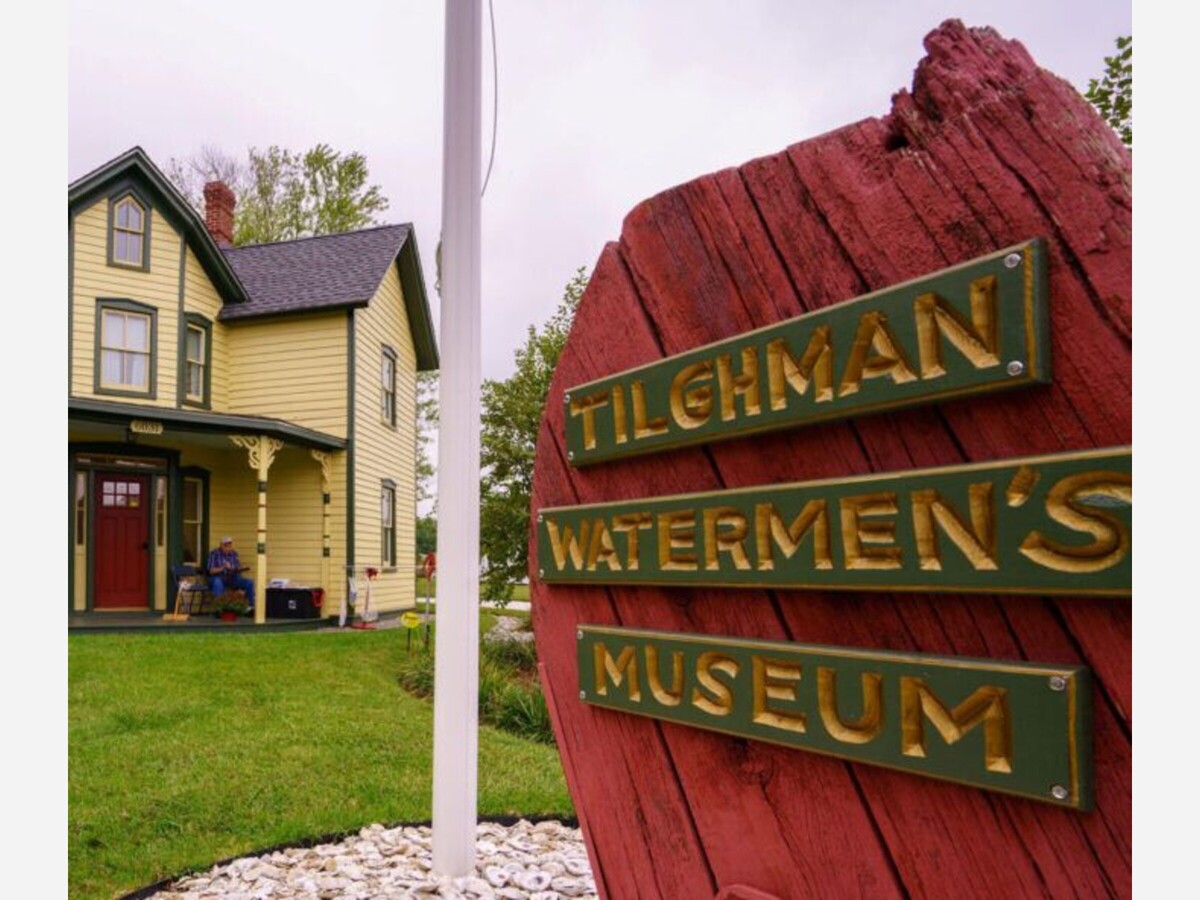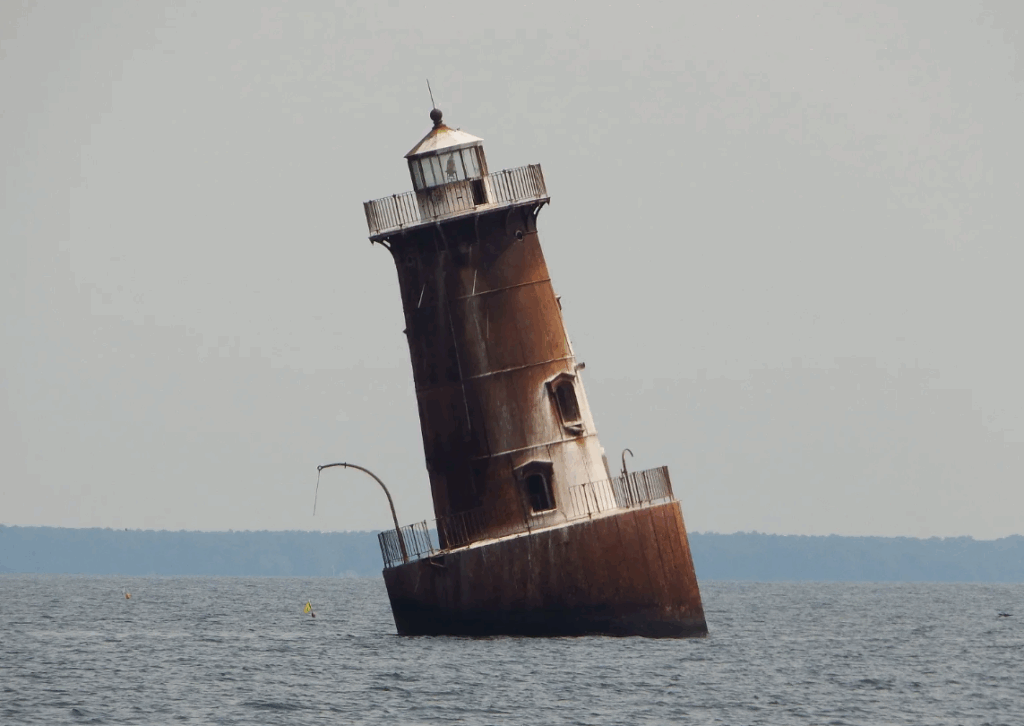Image


Sharps Island Light is the only hint of an island that was once hundreds of acres. Photo from Chesapeake Chapter, United States Lighthouse Society, by Greg Krawczyk
Sharps Island Remembered: Tilghman Watermen’s Museum Reopens with New Exhibit
By Meg Walburn Viviano, Bay News
When the Tilghman Watermen’s Museum reopened for the season last weekend, it debuted a new exhibit that tells the story of long-gone Sharps Island.
The only sign of Sharps Island today is a noticeably leaning, sparkplug-style lighthouse. It marks the shoals at the mouth of the Choptank River off Poplar Island and Black Walnut Point. It’s hard to imagine that the area near Sharps Island light was once an island up to 700-acres large, but some people in Tilghman still remember when there was some island left to see.
The Tilghman Watermen’s Museum, which records the lifestyle of watermen and the things they do, was founded by Hall and Mary Kellogg in 2008 because the couple saw the old Tilghman Island way of life disappearing.
 A sneak peek at part of the exhibit
A sneak peek at part of the exhibitThis new exhibit is modeled on the museum’s Tilghman exhibits, which proved popular for their accounts of real people, with artifacts and using the memories of distinctive island residents. The museum’s approach is to give visitors “a history lesson with some stories thrown in,” says museum board member Bonnie Messick.
The Sharps Island exhibit covers Sharps history spanning from Captain John Smith’s exploration in 1608, when the island measured hundreds of acres, until its demise in the 1950s. The museum owes its early Sharps Island history to Smithsonian researcher Darrin Lowery, Ph.D., a “local kid made good,” as Messick tells us. Lowery has published work on the vanished Sharps Island in his study of coastal erosion through history. Lowery has a large collection of artifacts dating back thousands of years from Sharps, including arrowheads and pipes. Some items like those are part of the new exhibit.
 Lowery published this overlaid map reflecting the drastic shrinking of Sharps Island from 1848 to 1952.
Lowery published this overlaid map reflecting the drastic shrinking of Sharps Island from 1848 to 1952.The island’s role as a navigational aid is its longest-lasting legacy. There have been three Sharps Island Lights over the years, beginning with a portable light station built on the island itself in 1838. It had a wooden keeper’s quarters with a lantern built on top, according to Lighthousefriends.com. It was already obvious that erosion was quickly wearing the island down, and so in 1848 the portable lighthouse was moved farther inland. In 1866, a new screwpile lighthouse was built offshore, about four miles off Tilghman Island. It was no match for the heavy ice that formed multiple times over the next two decades, and the lighthouse was carried away entirely in February 1881. Amazingly, the keepers stayed on the lighthouse for 16 hours as it drifted five miles to another island.
In 1822, the third and final Sharps Island light was built. The cast-iron, concrete-filled caisson had a brick-lined, iron tower and Fresnel lens, along with a fog warning bell. This lighthouse proved sturdier, but it got its modern-day 15-degree tilt during the deep freeze of 1977. The three Sharps Island lighthouses were manned by lightkeepers until the final lighthouse was automated in 1951. The exhibit includes history of the light and its keepers, including a log shared by the daughter of the last lightkeeper.
The exhibit also covers the many owners of the island, which was primarily used for farmland. As the island was whittled down by the Bay, at least one owner tried to claim the historical 700 acres, now underwater, for oyster beds, to no avail.
Wealthy shoe manufacturer Miller R. Creighton bought Sharps Island in 1895 with plans to build a hotel. The island was already losing several feet each year to the Bay, as its location was especially vulnerable to wind and tides. However, Creighton and two business partners pushed forward with construction of a three-story hotel adorned with six gables and a long boardwalk that led to a steamboat landing on the Bay. By 1900, the steamboat pier had washed away, according to Lighthouse Friends’ historical account. Messicks recalls the hotel never actually opened, and locals stripped it of everything. “Tilghman islanders weren’t going to let all that go to waste,” she tells us. “They say there wasn’t a house in Tilghman built in the early 1900s that didn’t have a piece of the hotel.”
In the 1930s, Tilghman residents recall that Sunday school classes would go to Sharps Island for swimming outings. It was used for bombing pratice by the U.S. Navy during World War II, and many watermen have pulled up bullet casings and smoke bombs while dredging or tonging in local waters. You can see examples of these artifacts in the new exhibit.
When the U.S. government bought the island in 1943, it was down to 6.5 acres. The watermen say 1954 is when the island disappeared under the water for good. Messick, who is in her 70s, was alive to see it, but it disappeared shortly after she was born. The wind and tides overcame it. “It never could have lasted long with all that nature bearing down on it,” she says.
The strength of the exhibit, like so much of the Tilghman Watermen’s Museum, is its “homespun” style. It’s more about the firsthand accounts, Messick says: “We get good reviews for our real stories, not just reciting history.”
The Tilghman Watermen’s Museum will open on weekends only starting May 10th.